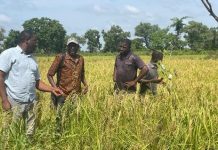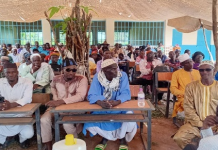By Assan Bah
In the early hours of March 31, a sudden fire swept through the Serekunda Sandika, reducing over ten vendor sheds to ashes and causing massive material loss to more than 40 traders. For many, it was more than a fire — it was the beginning of what they fear may become a forced uprooting of their lives and livelihoods.
The Sandika, a bustling wholesale market located within the dense commercial area of Serekunda, is now at the center of a contentious debate between the Kanifing Municipal Council (KMC) and its long-serving vendors. In the days following the fire, the KMC announced plans to relocate the Sandika, citing congestion, safety concerns, and accessibility issues. But for vendors like Mariama Jobe, who has spent years making a living in this tightly packed but thriving corner of the city, moving away is simply not an option.
“This is where we earn our daily bread,” Jobe said, standing near her stall, now reduced to a wooden table shaded by a single umbrella. “This is how I pay for school fees, rent, water, and electricity. We have nowhere else to go.”
KMC Mayor Talib Ahmed Bensouda defended the relocation plan, arguing that the current site is no longer viable for wholesale activities. “The Sandika, which is a council property, cannot continue to be where it is. It’s congested, situated right next to a hospital, and the roads are too narrow for the large trucks that deliver goods from as far as Guinea,” he said during a press conference. He added that the council and the Sandika Association had conducted a joint tour of alternative sites and agreed to move.
However, vendors say no consensus was reached. “We were only shown potential sites, but we never agreed to move,” said Tamsir Saho, the Sandika Association’s adviser. “We told them clearly that until a suitable place is found, we must be allowed to continue selling here, even with temporary structures.”
In the immediate aftermath of the fire, vendors returned with makeshift setups to resume business. The council allowed this on the condition that no permanent structures be erected, but on April 8, according to Jobe, KMC staff ordered them to remove even those temporary shelters by 7 p.m. “How are we supposed to work without any cover from the sun or rain?” she asked.
The council says relocation is a step toward modernization. Market Manager Modou A. Njie told Foroyaa that the council and the vendors’ committee had “unanimously” agreed to decongest the space and build a new, standardized Sandika with proper facilities. Yet he admitted, “The question remains — where will it be built?”
So far, potential relocation sites have included Bundung Jola Kunda, Abuko Market, and the Gambia Transport Union’s truck queue center in Abuko. But vendors have rejected each. “Bundung is inaccessible during the rainy season, and the Abuko site is difficult for both vendors and customers,” Jobe explained.
Njie disputes these claims, saying the Bundung site is more spacious than the current one and better connected by roads. Though he acknowledged logistical setbacks: “The site the vendors prefer in Abuko belongs to GAMTEL, not the council. We cannot develop land we don’t own.”
Another issue complicates the matter further — the question of who actually owns the land the Sandika currently occupies.
Sering Babacarr Jobe, the Alkalo of Serekunda, said the land belongs to the Sayerr Jobe family, the traditional custodians of Serekunda, and was never officially transferred to the council or the government.
“KMC once brought me papers to sign over occupancy rights, but I refused. I didn’t have permission from the community to give away land that belongs to us all,” he said. “We’re even in the process of leasing it officially in the name of the Serekunda community.”
Jobe said the land was initially occupied by small shops before local traders transformed it into a wholesale market decades ago.
“KMC, which was once the Kombo Road Authority, and later KUBC before becoming KMC, has only been managing the area, not owning it,” he said. “If they want to take the land, they must engage the community in dialogue. We’re not against development, but we must benefit from it too.”
Njie, the market manager, said he only became aware of the land ownership dispute after the fire. “We’ve been managing that market for years. We built restrooms, installed solar lights, and provided water,” he said. “But it’s true that the sheds themselves were built by the vendors, and they weren’t properly arranged.”
For now, the Sandika remains in limbo as vendors continue to trade in the open, unsure how long they’ll be allowed to stay. The council has formed a task force with members of the Sandika Association to continue discussions, but no formal decision has been made.
“We agreed in principle to relocate, but only if we find a place that works for everyone,” said Saho.
Back at the Sandika, smoke from the fire has long cleared, but its aftermath still hangs heavily in the air. Vendors work cautiously, building temporary stalls in defiance of orders, fearing eviction, but more afraid of losing their only source of income.
As Serekunda’s largest wholesale hub teeters between demolition and preservation, the standoff highlights a deeper struggle in The Gambia’s urban landscape — one between development and displacement, between policy and people, and between the urgency to modernize and the need to survive.


















